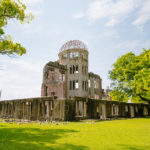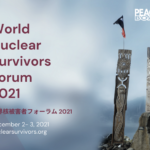Executive Summary: Nuclear Trends in 2021
The global pandemic of COVID-19 has significantly impacted nuclear issues from various dimensions. Among other things, the Nuclear Non-Proliferation Treaty (NPT) Review Conference (RevCon), which was originally scheduled to be held in April- May 2020, has been postponed four times as of January 2022, and is currently being considered to convene in August 2022. Various other conferences on nuclear issues were also postponed or cancelled. In addition, a number of meetings could be held only in a limited manner, either entirely online or as a hybrid of online and face-to-face communication. Furthermore, as the public and private sectors around the world have struggled to address the pandemic, interest in nuclear disarmament and nonproliferation issues seemed to have receded.
In 2021, a modicum of progress was made. Overall, however, the nuclear situation shows few signs of improvement from the previous year, and rather seems to be in a spiral of impasse and aggravation. The major trends in nuclear disarmament, nonproliferation and nuclear security observed in 2021 are as follows.
(1) Nuclear Disarmament
Since the end of the Cold War, the overall number of nuclear weapons has been decreasing. Still, an estimated 13,080 nuclear weapons remain on the Earth, and nuclear-armed states continue to modernize their nuclear arsenals. In February 2021, the United States and Russia agreed to a five-year extension of the New Strategic Arms Reduction Treaty (New START). However, nuclear-armed states, including Russia and the United States, have yet to come to decisions regarding further reductions of their nuclear weapons. The entry into force of the Comprehensive Nuclear-Test-Ban Treaty (CTBT) and negotiations on the commencement of a Fissile Material Cut- Off Treaty (FMCT) have not yet been achieved. Despite growing interest in efforts to reduce the role of nuclear weapons, nuclear-armed states appear to have increased their reliance on nuclear deterrence.
In the meantime, the number of countries signing or ratifying the Treaty on the Prohibition of Nuclear Weapons (TPNW)—which, inter alia, legally bans states from possessing and using nuclear weapons—has steadily increased, with the treaty entering into force on January 22, 2021. Despite this, nuclear-armed states and their allies have stated their intention not to sign the treaty. Their refusal reveals a deepening rift over nuclear disarmament between nuclear-armed states and their allies on one side, and NNWS on the other.
The Status of Nuclear Forces (estimates)
➢ Approximately 13,080 nuclear weapons (estimated) still exist on the Earth. The pace of their reduction has slowed. On the other hand, the number of nuclear warheads—excluding those awaiting dismantlement—and the number of warheads deployed in operational forces both increased.
➢ China, India, Pakistan and North Korea have been gradually increasing their stockpiles of nuclear warheads for more than a decade. In 2021, it was estimated that the number of U.K.’s nuclear warheads also increased.
Commitment to Achieving a World without Nuclear Weapons
➢ No country openly opposes the goal of “the total elimination of nuclear weapons” or “a world without nuclear weapons.” However, steady and concrete implementation and promotion of nuclear disarmament toward the realization of this goal was not seen in 2021.
➢ The five nuclear-weapon states (NWS), as well as non-nuclear-weapon states (NNWS) participating in the Stockholm Initiative, continue to discuss measures to reduce nuclear risks. The United States and Russia reaffirmed the principle that a nuclear war cannot be won and must never be fought.
➢ On the Japan-led UN General Assembly (UNGA) Resolution titled “Joint courses of action and future-oriented dialogue towards a world without nuclear weapons,” 158 countries, including France, the United Kingdom and the United States, voted in favor. However, China and Russia voted against it. Furthermore, some TPNW proponents abstained.
TPNW
➢ The TPNW entered into force on January 22, 2021. By the end of 2021, 59 countries have become states parties to the treaty.
➢ Proponent countries of the TPNW emphasize the importance of the treaty in promoting nuclear disarmament and establishing a norm against nuclear weapons. The UNGA adopted a resolution calling for further signature, ratification and accession of the treaty.
➢ Nuclear-armed states and their allies remain opposed to the TPNW. Meanwhile, Germany, Norway, Sweden and Switzerland expressed their intention to participate as observers in the first Meeting of the States Parties to the TPNW in March 2022.
Reduction of Nuclear Weapons
➢ Russia and the United States agreed to a five-year extension of the New Strategic Arms Reduction Treaty (New START). They continue to comply with the treaty.
➢ The United States and Russia launched the Strategic Stability Dialogues to discuss future arms control and other issues, and two meeting were held in 2021.
➢ China reiterated that it would not join such negotiations unless the two countries possessing the largest nuclear arsenals make drastic and substantive reductions.
➢ All nuclear-armed states continue to modernize their nuclear forces. In particular, China and Russia have been aggressively pursuing the development and deployment of various new delivery
vehicles for carrying nuclear warheads.
Diminishing the Roles and Significance of Nuclear Weapons in the National Security Strategies and Policies
➢ There have been few significant changes in nuclear policies regarding the following: the role and significance of nuclear weapons; a “sole purpose” or no first use policy; negative security assurances; and extended nuclear deterrence. Reportedly, U.S. allies also did not express support for a U.S. adoption of such policies.
➢ The United Kingdom announced its nuclear policy that it would increase the limit on the number of nuclear weapons it possesses while maintaining its existing operational posture.
➢ In response to the indication that China’s policies of minimum deterrence and no first use of nuclear weapons is changing, China emphasized that its nuclear policy and posture remain unchanged.
De-Alerting or Measures for Maximizing Decision Time to Authorize the Use of Nuclear Weapons
➢ There have been few significant changes in NWS policies concerning alert status. Russian and U.S. strategic nuclear forces are considered to remain on high alert status.
➢ China denied an allegation that it has been putting some of its nuclear forces on higher alert.
CTBT
➢ Among the 44 states listed in Annex 2 of the CTBT, whose ratification is a prerequisite for the treaty’s entry into force, five states (China, Egypt, Iran, Israel and the United States) have signed but not ratified, and three (India, Pakistan and North Korea) have not even signed.
➢ With the exception of North Korea, all countries which have declared possession of nuclear weapons maintain moratorium on nuclear test explosions. Since 2018, no country has conducted a nuclear explosion test. The United States claimed that China and Russia conducted non-“zero yield” nuclear tests, but China and Russia denied the allegations.
➢ North Korea declared at the end of 2019 that it would no longer be bound to its previous decision to unilaterally suspend nuclear testing. However, it did not conduct a nuclear test in 2021.
➢ Some nuclear-armed states are considered to have conducted nuclear tests without explosions. In 2021, Russia announced that it conducted a subcritical experiment.
FMCT
➢ At the 2021 session of the Conference on Disarmament (CD), negotiation of an FMCT yet again failed to be commenced. Pakistan continued to oppose even negotiating a treaty prohibiting just the production of fissile material for nuclear weapons.
➢ China, India, Israel, Pakistan and North Korea have yet to declare a moratorium on the production of fissile material for nuclear weapons. All of these countries, with the exception of China, are considered to maintain their production.
Transparency in Nuclear Forces, Fissile Material for Nuclear Weapons, and Nuclear Strategy/Doctrine
➢ The United Kingdom declared its policies to extend deliberate ambiguity, including the number of nuclear weapons it possesses, and to impose certain restrictions on transparency.
➢ While the amount of information released by the United States decreased during the former Donald Trump administration, the Joseph Biden administration altered such a policy and declassified information regarding the number of its nuclear weapons stockpiles and dismantled nuclear warheads.
Verifications of Nuclear Weapons Reductions
➢ Countries participating in the International Partnership for Nuclear Disarmament Verification (IPNDV), which was launched by the United States, continue further discussions and deliberations on verification measures— including virtual exercises.
Irreversibility
➢ Russia and the United States continue to dismantle or convert, to some extent, their strategic delivery vehicles, nuclear warheads, and fissile material declared excess for military purposes.
Disarmament and Non-Proliferation Education and Cooperation with Civil Society
➢ While facing many limitations and difficulties due to the global COVID-19 pandemic, government officials, experts, NGOs, and other civil society groups engaged in active discussions at online meetings and other events.
➢ Some countries have started to legislate “divestment” against, or prohibit lending to, organizations and companies which are involved in producing and developing nuclear weapons. The number of companies which have individually established such policies is also increasing.
Hiroshima and Nagasaki Peace Memorial Ceremonies
➢ Representatives from 83 countries attended the peace memorial ceremony in Hiroshima, and 63 countries represented at the ceremony in Nagasaki. While the scale of the ceremonies was reduced due to the pandemic of COVID-19, the number of participating countries remained at the same level as the previous year.
(2) Nuclear Non-Proliferation
As of December 2021, 191 countries (including the Holy See and Palestine) have acceded to the Nuclear Non-Proliferation Treaty (NPT). However, three nuclear-armed states—India and Pakistan which possess nuclear weapons, and Israel which has not denied possessing them—remain outside and are unlikely to join the treaty in the near future. North Korea has not made a strategic decision on renouncing its nuclear weapons. Regarding the Joint Comprehensive Plan of Action (JCPOA), as a countermeasure against the U.S. withdrawal in 2018, Iran has steadily expanded its suspension of adherence to the nuclear limits of the deal.
The number of countries that accept the International Atomic Energy Agency (IAEA) safeguards under the Additional Protocols has increased steadily. Still, more than 40 countries have not yet signed them. On export controls, most members of the Nuclear Suppliers Group (NSG) have solid export controls in place. On the other hand, there are concerns that North Korea is continuing to engage in illicit trafficking and procurement activities for its nuclear and missile programs.
Acceptance and Compliance with the Nuclear Non-Proliferation Obligations
➢ No progress has been made to resolve the North Korean nuclear issue. Pyongyang has continued to bolster its nuclear and missile capabilities.
➢ In opposition to the U.S. withdrawing from the JCPOA and its enhancement of sanctions on Iran, since the latter half of 2019, Tehran has steadily expanded the areas from which it has withdrawn from its own obligations under the JCPOA; such as, inter alia, its stockpile of enriched uranium, level of enrichment, and the number of centrifuges. Iran also produced 20% and 60% highly enriched uranium (HEU) as well as uranium metal.
IAEA Safeguards
➢ As of 2021, 132 NPT NNWS have concluded the IAEA Additional Protocols. Some countries such as Brazil argue that the conclusion of an Additional Protocol should be voluntary, not obligatory under the NPT.
➢ The IAEA applied integrated safeguards to 66 NNWS by the end of 2020. In addition, as of June 2021, the Agency developed and approved state-level safeguards approaches (SLAs) for 135 countries.
➢ In February, Iran suspended verification and monitoring measures under the JCPOA, including the provisional application of the Additional Protocol to the IAEA Safeguards Agreement. The IAEA was also unable to access data from surveillance cameras, online enrichment monitors and electronic seals installed at Iran’s nuclear facilities.
➢ The IAEA reported that it could not resolve the issues regarding the accuracy and completeness of declarations for four sites related to the alleged Iran’s past clandestine nuclear program. The IAEA has demanded that Iran provide further clarifications and information.
➢ Saudi Arabia is nearing completion of its first research reactor, but has not yet concluded a comprehensive safeguards agreement with the IAEA nor accepted a modification to its Small Quantities Protocol (SQP).
➢ Australia, the United Kingdom, and the United States under a new security partnership, named AUKUS, agreed to promote the introduction of Australia’s nuclear-powered submarines, and discussed the implementation of IAEA safeguards for their nuclear fuel. Some countries, including China and Russia, expressed criticism and concerns regarding three countries’ decision.
Implementing Appropriate Export Controls on Nuclear-Related Items and Technologies
➢ Most members of the NSG have solid export controls in place, including establishment of legislative measures and other relevant national implementation systems. On the other hand, many countries, in particular developing countries, have been requested to strengthen their systems and their implementation of export controls.
➢ North Korea continues to engage in illicit trafficking and procurement through, inter alia, ship-to-ship transfers and cyber activities.
➢ The discussion over India becoming a member of the NSG has continued, but no agreement has yet been reached. Some countries have proactively promoted civil nuclear cooperation with India despite it being a non-party to the NPT, while others are contemplating cooperation, subject to implementing additional nuclear disarmament and nonproliferation measures.
➢ China has been criticized for its export of nuclear power reactors to Pakistan, which may constitute a violation of the NSG guidelines.
➢ It has been alleged that countries proliferation concern, especially North Korea and Iran, have engaged in nuclear and missile development cooperation. China’s support for missile development in Pakistan and other countries has also been pointed out as a potential area of concern.
Transparency in the Peaceful Use of Nuclear Energy
➢ As of the end of 2021, China and Russia did not submit their respective reports based on the Guidelines for the Management of Plutonium.
(3) Nuclear Security
In 2021, no major international conference on nuclear security was held. Largely due to this, the amount of information announced or made publicly available regarding national efforts and achievements in strengthening nuclear security was limited.
Overall, the momentum of high-level political efforts to strengthen international nuclear security has been declining. With nuclear security threats such as cyberattacks, drones, and insider threats increasing, one can observe many situations where efforts to foster a nuclear security culture must be redoubled. Fostering nuclear security culture is essential for implementing sustainable and effective nuclear security measures. Stocks of weapon-usable nuclear material as a whole are still on the increase, in particular plutonium for civilian use continues to increase.
In Japan, unauthorized use of ID by an operating staff at the TEPCO Kashiwazaki-Kariwa Nuclear Power Station made us aware of the need to strengthen measures against insider threats, including efforts to further fostering of nuclear security culture.
Progress has been seen in areas such as adherence to nuclear security related conventions, minimization of HEU, nuclear forensics capabilities, and human resource development at the national and regional levels. The Review Conference of the Amendment to the Convention on the Physical Protection of Nuclear Material (CPPNM/A), which was scheduled for 2021, has been postponed to March 2022. It is expected that each country will proactively share information on the national implementation of the convention and discuss the universalization and effective implementation of the convention.
Physical Protection of Nuclear Material & Nuclear Facilities
➢ Stocks of weapon-usable nuclear material around the world were still on the increase in 2021. While stocks of HEU have shown a trend of decrease, those of separated plutonium are rising, due to the increase of stocks for civilian use.
➢ Twenty-one out of 36 surveyed countries still possess fissile material that could be attractive to terrorists. Efforts to minimize HEU are underway in several countries, but no country has completely eliminated such material in 2021.
Accession to Nuclear Security and Safety- Related Conventions, Participation in Nuclear Security-Related Initiatives, and Application to Domestic Systems
➢ The Philippines ratified CPPNM/A in June, leaving only five of the surveyed countries that have yet to ratify. South Africa is in the final stages of domestic ratification process of the CPPNM/A. It is commendable that the number of adherents is gradually increasing for all relevant conventions.
➢ A decrease in information dissemination/announcements, particularly direct reference to the implementation of measures recommended in the “Nuclear Security Recommendations on Physical Protection of Nuclear Material and Nuclear Facilities (INFCIRC/225/Rev.5)” is becoming more prominent. There is room for enhancing measures against the threat of drones as well as cyber-attacks on nuclear facilities, insider threats, as well as overall improvements in nuclear security culture.
Efforts to Maintain & Improve the Highest Level of Nuclear Security
➢ Regarding the minimization of HEU for civilian use, work toward the removal of such material has progressed in Canada and Kazakhstan. Also, efforts to develop alternative technologies to HEU are underway in some countries.
➢ Six countries, including Turkey, have received the IAEA’s International Physical Protection Advisory Service (IPPAS) mission, though none were conducted in 2021.
➢ Multilateral nuclear security efforts seemed to be limited, largely due to the COVID-19 pandemic. Meanwhile, some countries have solicited supporters in the form of INFCIRC documents—which are IAEA information documents, based on various basket proposals from the Nuclear Security Summit process—and continue and strengthen nuclear security efforts on different subject. For example, the International Working Group promoting Insider Threat Mitigation (INFCIRC/908), established in 2020, initiated its activities in 2021.








